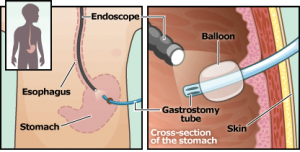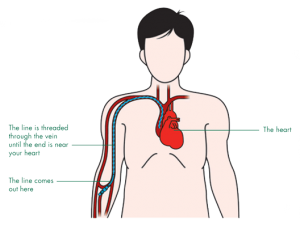TREATMENTS
Lines, Tubes, Hookups, and Alternative Treatments
*Please note: Avery’s Angels neither endorses nor disagrees with the efficacy, safety, or preference for any of the procedures below. This page is intended as information only. Always speak with your surgeon or other medical professionals as needed to determine the best course of treatment for your child. Individual results may vary.*
Replogle Tube
This tube is run down through the nose or throat to the stomach to drain out any stomach acid that is not passing through the intestinal system. This tube will be set to suction and will drain out brownish colored stomach acid. When it runs from brown to light green to clear, this is an indication that things are moving through the stomach and feedings may be possible. (Hence our awareness color….the “gastroschisis green” is a positive sign!)
Nasogastric Intubation (NG Tube)
An NG Tube is a small tube that carries food or medicine to the stomach through the nose. Parents should take caution to try to keep their children from pulling on this tube, and should make caring for the NG tube part of their daily routine. This may include cleaning your child’s skin around the tube and “flushing” the tube with water after each feeding.1
Nasojejunal Tube (NJ tube)
A NJ Tube is similar to an NG tube, only longer. It bypasses the stomach and provides nutrients directly to the intestines; this is best for children who have issues with frequent vomiting. These are always temporary and good for children who do not pull out their tubes or who only require this for a short term solution. Longer term feeding needs will require a permanent GJ tune or J tube.2
 Gastrostomy Tube (G Tube)
Gastrostomy Tube (G Tube)
A G Tube is a surgically placed feeding tube that runs directly to the stomach in order to provide those who have trouble eating with adequate fluids and nutrition. The surgical procedure to place a G tube takes approximately 45 minutes, and after a short hospital stay children can return to normal activities. The tube can remain in place for several months before needing to be replaced, which can often occur without additional surgery.3 The most common procedure to place a G tube is the PEG procedure, as seen in the graphic below. 4
 Jejunostomy Tube (J tube)
Jejunostomy Tube (J tube)
A J Tube is a feeding tube that is inserted through the abdominal wall into the jejunum or small intestine. This is utilized when long term feeding complications are present, and when there are additional complications with digestion or gastric emptying. {See image below} Contact your doctor for further informtion.5
Peripherally Inserted Central Catheter (PICC Line)
 A PICC line is how nutrients called TPN (total parenteral nutrition), can be supplied to those who are unable to be fed by mouth. It is inserted through the arm similar to a typical IV, but goes deeper into the body and has less complications and can be kept in place longer. A PICC line tends to be safer than traditional IV when needed for long term care. For babies, some of the best access sites maybe on the head because their veins are too small.6
A PICC line is how nutrients called TPN (total parenteral nutrition), can be supplied to those who are unable to be fed by mouth. It is inserted through the arm similar to a typical IV, but goes deeper into the body and has less complications and can be kept in place longer. A PICC line tends to be safer than traditional IV when needed for long term care. For babies, some of the best access sites maybe on the head because their veins are too small.6
Broviac Line
A Broviac Line is another line option that is surgically placed to supply TPN for babies. Broviac lines tend to be ideal for smaller patients, and the primary different is the location of placement – broviacs are in the chest vs. PICC lines which tend to be in the arm. As such, broviacs come with a slightly elevated risk of infection and sepsis
and must be kept clean at all times.7
 Total Parenteral Nutrition (TPN)
Total Parenteral Nutrition (TPN)
TPN is used for those who cannot tolerate obtaining their nutrition by mouth. Gastroschisis infants requires TPN initially. TPN may include a combination of sugar and carbohydrates, proteins, lipids, electrolytes, and trace elements.TPN can have side effects including liver damage, but is required to receive nutrition. Talk to your doctor for more information.9
Omegaven
Omegaven is a TPN substitute that does not have the negative liver implications of TPN. The United States does not utilize Omegaven as the “gold standard” for gastroschisis parenteral nutrition because of FDA regulations. Omegaven uses Omega 3 fatty acids as opposed to Omega 6 fatty acids. Talk to your doctor for more information.10Currently, only a very select few hospitals in the United States are allowed to use Omegaven under compassionate care provisions from the FDA. The manufacturer of Omegaven provides this for expanded use in the United States. How to obtain Omegaven can be found in footnotes 11and 12.
 Serial Transverse Enteroplasty (STEP)
Serial Transverse Enteroplasty (STEP)
STEP is a bowel lengthening procedure designed for short bowel syndrome patients who are dependent on IV nutrition. The goal is to improve the blood supply to the bowels by lengthening the intestines through a surgical zig zag pattern. {See image below} Efficacy is still ongoing, and there is an international registry for data analysis of patients who have received this procedure.13
Motility Clinics
Short bowel and motility issues are prevalent with gastroschisis patients. Many reputable Children’s Hospitals offer motility and gastrointestinal rehabilitation centers with non-surgical interventions.14
 Wound Vac
Wound Vac
A device used to promote healing and growth of a large wound/opening. It applies negative pressure to the area, draws out fluids and increases blood flow. The dressing is changed 2-3 times a week. This allows time for the body to grow. For abdominal openings that are too large to close, it is important for the growth of the abdominal muscles to help safely close the defect.15
If your child leaves the hospital with any of these attachments or procedures, it is important to ask the hospital social worker about how to connect with a home health nurse prior to your departure.
- http://www.nlm.nih.gov/medlineplus/ency/patientinstructions/000182.htm
- http://articles.complexchild.com/oct2009/00158.html
- http://kidshealth.org/parent/system/surgery/g_tube.html#
- http://ghpsi.com/gtube.html
- https://www.roswellpark.org/patients/jejunostomy-tube
- http://picclinenursing.com/picc_why.html
- http://www.ehow.com/about_5063649_boviac-catheter.html
- http://surgery.med.umich.edu/pediatric/patient/conditions/A-M/broviac_placement.shtml
- http://www.nlm.nih.gov/medlineplus/druginfo/meds/a601166.html
- http://www.nebraskamed.com/transplant/news-6-11-2009.aspx
- http://www.fda.gov/Drugs/DevelopmentApprovalProcess/HowDrugsareDevelopedandApproved/ApprovalApplications/InvestigationalNewDrugINDApplication/ucm368740.htm
- http://www.oley.org/documents/How_Physicians_Can_Obtain_Omegaven.pdf
- https://apps.childrenshospital.org/clinical/step/
- http://www.ncbi.nlm.nih.gov/pmc/articles/PMC3088841/
- http://www.ncbi.nlm.nih.gov/
pubmed/21780019
